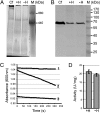Aerobic kinetoplastid flagellate Phytomonas does not require heme for viability
- PMID: 22355128
- PMCID: PMC3309753
- DOI: 10.1073/pnas.1201089109
Aerobic kinetoplastid flagellate Phytomonas does not require heme for viability
Abstract
Heme is an iron-coordinated porphyrin that is universally essential as a protein cofactor for fundamental cellular processes, such as electron transport in the respiratory chain, oxidative stress response, or redox reactions in various metabolic pathways. Parasitic kinetoplastid flagellates represent a rare example of organisms that depend on oxidative metabolism but are heme auxotrophs. Here, we show that heme is fully dispensable for the survival of Phytomonas serpens, a plant parasite. Seeking to understand the metabolism of this heme-free eukaryote, we searched for heme-containing proteins in its de novo sequenced genome and examined several cellular processes for which heme has so far been considered indispensable. We found that P. serpens lacks most of the known hemoproteins and does not require heme for electron transport in the respiratory chain, protection against oxidative stress, or desaturation of fatty acids. Although heme is still required for the synthesis of ergosterol, its precursor, lanosterol, is instead incorporated into the membranes of P. serpens grown in the absence of heme. In conclusion, P. serpens is a flagellate with unique metabolic adaptations that allow it to bypass all requirements for heme.
Conflict of interest statement
The authors declare no conflict of interest.
Figures



References
-
- Frankenberg N, Moser J, Jahn D. Bacterial heme biosynthesis and its biotechnological application. Appl Microbiol Biotechnol. 2003;63:115–127. - PubMed
-
- Panek H, O'Brian MR. A whole genome view of prokaryotic haem biosynthesis. Microbiology. 2002;148:2273–2282. - PubMed
-
- Schenkman JB, Jansson I. The many roles of cytochrome b5. Pharmacol Ther. 2003;97(2):139–152. - PubMed

